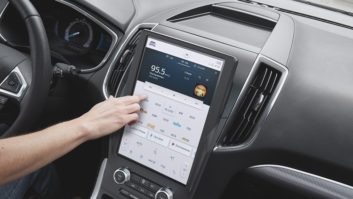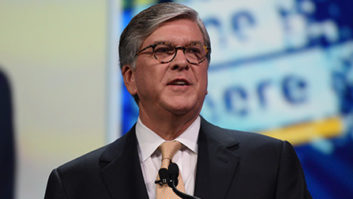ALEXANDRIA, VA.
As new studies indicate the American public is now using more than one-third of its leisure time watching TV—notably with half of all viewers watching some content on computers, tablets and smartphones—the dual additions this fall of Apple TV and Google TV could change the way a lot of people watch television in their living rooms, too.

Google Inc. CEO Eric Schmidt introduces Google TV at a press conference in May. After its initial appearance four years ago, a revamped Apple TV’s hardware is now a smaller box going for less than $100, in order to “rent” TV shows streamed from its iTunes Store for 99 cents per episode. (Movie rentals range from $3-$5.) Google TV will allow users to overlay Google content and outside-produced “apps” on family-room TV sets and, eventually, on tablet-type computers using Google’s Chrome OS. According to the online tech site, Engadget, Google is planning to launch its new TV service by the middle of this month. At least one set maker, Sony, plans to include Google TV within some of its TV models in plenty of time for the upcoming holiday sales season. Other makers such as Samsung are expected to follow Sony’s lead quickly.
NONLINEAR CATCHING UP
Google and Apple don’t appear to be leading the charge into widening non-linear TV options as much as taking advantage of already-emerging consumer habits. According to a recent study by Ericsson ConsumerLab of TV consumers in the U.S., China and Western Europe, 93 percent still watch linear broadcast TV on a weekly basis. But, the study finds, “More than 70 percent are streaming, downloading or watching recorded broadcast TV.” In-Stat, a market researcher, predicts there will be 57 million households in America watching full-length movies online via their digital TV sets by 2014.
While a majority of broadcasters contacted on this trend chose not to comment for the record, a few others believe the start-up of Apple TV and Google TV could end up having a healthy effect, if any at all, on traditional broadcasting.

Apple is relaunching its Apple TV service this month “If Google TV and Apple TV have any impact, I believe it will be positive, as it may drive more people to traditional television,” said Paul Karpowicz, president of Meredith Local Media Group, a division of Meredith Corp., which owns a dozen TV stations. “Instead of sitting at a computer, the TV will become the device-of-choice for both TV viewing and surfing the Internet. Because the consumer is already sitting in front of the TV, they may watch more traditional television. Over the years, we’ve determined that viewers do not want TV to be interactive. They prefer to sit back and be entertained, instead of engaging in a cooperative activity like Apple TV or Google TV,” Karpowicz said.
Laura Cowan, who chairs the Media Consumption & Engagement Committee of the Nielsen-funded Council for Research Excellence, also doesn’t see emerging services like Apple TV as a serious threat. “We tend to find these new technologies to be additive to, and not a substitute for, traditional media habits. The council’s Video Consumer Mapping study proved that screen time is simply increasing. Nielsen’s Three Screen Report also indicates this, and was itself validated by the VCM findings. And as we’ve seen in the VCM and in more recent research, concurrent media exposure is expanding,” said Cowan.
JUST ANOTHER BOX?
Analyst Bruce Leichtman is a bit blunter. “I don’t see much of an impact, frankly, from what Apple TV had originally offered to begin with back in 2006. Maybe a lower price now, sure. But Apple TV is another standalone box that consumers have traditionally rejected. One of the most successful boxes of all time is TiVo, and that only penetrated two percent of the U.S.,” said the head of Leichtman Research Group. “If we weren’t talking about the names ‘Apple’ or ‘Google,’ we wouldn’t be paying much attention to this. The new Apple TV to me looks and feels a heck of a lot like a Roku [box].”
Leichtman concedes Apple TV’s MSRP of $99 could make a small difference for some users. “But then when they look at it, they may ask, ‘So what do I get? Don’t I already get this on my Blu-ray, or on Netflix, on cable [DVR and VOD]?’ Apple and Google simply haven’t created better mousetraps here,” Leichtman said.
Longtime pubcaster Tom Axtell, general manager of KLVX-TV in Las Vegas, thinks new entries like Apple TV and Google TV could wind up curbing access to “vulnerable” viewers. Axtell, whose “Vegas PBS” operation recently relocated to its new 122,000-square-foot Educational Technology Campus, said Google and Apple are merely following in the footsteps of cable and satellite TV by “seeking to create a new set of consumer expectations” for what used to be free terrestrial television.

Paul Karpowicz, President, Meredith Corp. “Apple and Google hope to convince viewers to accept a pay-per-view approach for programs from network television,” Axtell said. “Public television has already invested heavily in making ‘free over the air programs’ now available on ‘free over the Internet’ Web sites. [But] clearly, low-income children will not watch as much educational television online if they are required to transition to a pay-per-view world.”
Perhaps Google TV’s service should be the one that broadcasters might want to keep a closer eye on, according to analyst James McQuivey at Forrester Research. “Most of the content Apple offers would represent maybe 30 minutes of viewing a day—roughly 12 percent of viewing time,” McQuivey said. “But Google TV has the potential to enhance and augment viewing, which would end up disrupting it. Because it would provide a Google overlay, app functionality, and search capabilities for the entire TV viewing experience, it’s much more powerful in concept… All those Google TV homes will create a base of customers for entirely new viewing, social and commercial experiences that neither [terrestrial] TV nor cable can provide.”
McQuivey thinks Google TV’s biggest impact could come from new apps that outside developers would create to enhance the viewing experience in the living room. “That’s something a broadcaster doesn’t want to have happen without being in control,” McQuivey said.
— TV Technology.com







